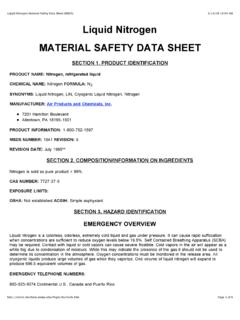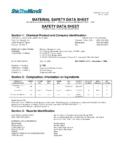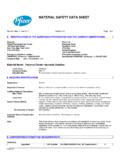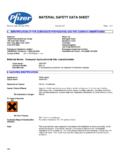Transcription of Material Safety Data Sheet - UTSA Department of …
1 Material Safety data Sheet acetone 1. CHEMICAL PRODUCT AND COMPANY IDENTIFICATION. PRODUCT NAME: acetone OTHER/GENERIC NAMES: 2-Propanone, -Keptopropane, Dimethylformadlehyde, Dimethyl Ketone, Methyl Ketone, Propanonene, Pyroacetic Ether PRODUCT USE: Solvent MANUFACTURER: Honeywell DISTRIBUTOR: VWR International 1953 South Harvey Street 1310 Goshen Parkway Muskegon, MI 49442 West Chester, PA 19380. FOR MORE INFORMATION CALL: IN CASE OF EMERGENCY CALL: (Monday-Friday, 8:00am-5:00pm) (24 Hours/Day, 7 Days/Week). 1-800-932-5000 1-800-424-9300 (USA Only). For Transportation Emergencies: 1-800-424-9300 (CHEMTREC - Domestic). 1-613-996-6666(CANUTEC- Canada). NOTE: Emergency telephone numbers are to be used only in the event of chemical emergencies involving a spill, leak, fire, exposure, or accident involving chemicals.
2 All non-emergency questions should be directed to customer service. 2. COMPOSITION/INFORMATION ON INGREDIENTS. INGREDIENT NAME CAS NUMBER WEIGHT %. acetone 67-64-1 100. Component Information/Information on Non-Hazardous Components This product is considered to be hazardous according to the criteria specified in 29 CFR (Hazard Communication Standard) and the Canadian Controlled Product Regulations. Trace impurities and additional Material names not listed above may also appear in Section 15 toward the end of the MSDS. These materials may be listed for local "Right-To-Know" compliance and for other reasons. 3. HAZARDS IDENTIFICATION. EMERGENCY OVERVIEW: This product is a clear, volatile, flammable liquid.
3 Has a sweet, mint-like odor. Highly flammable. Vapours may form explosive mixtures with air. The product causes irritation of eyes, skin and mucous membranes. Repeated exposure may cause skin dryness or cracking. Harmful by inhalation. Harmful: may cause lung damage if swallowed. Causes headache, drowsiness or other effects to the central nervous system. Do not allow product to contact skin, eyes and clothing. Do not breathe vapours. MSDS Number: BDH-110 Page 1 of 9. Current Issue Date: January 6, 2006. Material Safety data Sheet . acetone POTENTIAL HEALTH HAZARDS. SKIN: Irritating to skin. Skin absorption may cause toxic effects similar to those described for inhalation. Repeated or extended contact may cause erythema (reddening of the skin) or dermatitis, resulting from a defatting action on tissue.
4 EYES: Irritating to eyes. Symptoms include itching, burning, redness and tearing. INHALATION: Harmful by inhalation. Vapours may cause drowsiness and dizziness. Inhalation of high vapour concentrations can cause CNS-depression and narcosis. Severe overexposure may produce more serious symptoms, including coma and risk of kidney damage. INGESTION: Harmful: may cause lung damage if swallowed. Ingestion causes burning sensation in the mouth, throat and stomach and gastrointestinal disturbances. Ingestion of this product may result in central nervous system effects including headache, sleepiness, dizziness, slurred speech and blurred vision. DELAYED EFFECTS: Repeated or prolonged exposure may cause damage to the liver and kidney.
5 MEDICAL CONDITIONS Pre-existing respiratory diseases, liver or kidney dysfunctions, or central AGGRAVATED BY EXPOSURE: nervous system disorders may be aggravated by exposure. HMIS Ratings: Health: 2 Fire: 3 Physical Hazard: 0. Hazard Scale: 0 = Minimal 1 = Slight 2 = Moderate 3 = Serious 4 = Severe * = Chronic hazard Ingredients found on one of the OSHA designated carcinogen lists are listed below. INGREDIENT NAME NTP STATUS IARC STATUS OSHA LIST. No component of this product at levels greater than or equal to is identified as a carcinogen by ACGIH, IARC, NTP or OSHA. 4. FIRST AID MEASURES. SKIN: Wash off immediately with soap and plenty of water. Take off contaminated clothing and shoes immediately.
6 Wash contaminated clothing before re-use. Obtain medical attention. EYES: Rinse immediately with plenty of water, also under the eyelids, for at least 15 minutes. Obtain medical attention. INHALATION: Move to fresh air in case of accidental inhalation of vapours. If not breathing, give artificial respiration. If breathing is difficult, give oxygen, provided a qualified operator is available. Call a physician immediately. MSDS Number: BDH-110 Page 2 of 9. Current Issue Date: January 13, 2006. Material Safety data Sheet . acetone INGESTION: DO NOT induce vomiting. Immediate medical attention is required. If vomiting occurs naturally, have victim lean forward to reduce risk of aspiration. ADVICE TO PHYSICIAN: Treat symptomatically.
7 5. FIRE FIGHTING MEASURES. FLAMMABLE PROPERTIES. FLASH POINT: -4 F (-20 C). FLASH POINT METHOD: Closed Cup AUTOIGNITION TEMPERATURE: 869 F (465 C). UPPER FLAME LIMIT (volume % in air): 13. LOWER FLAME LIMIT (volume % in air): FLAME PROPAGATION RATE (solids): Not applicable OSHA FLAMMABILITY CLASS: Class 1B Flammable Liquid EXTINGUISHING MEDIA: Use alcohol-resistant foam, carbon dioxide (CO2) or dry chemical. UNUSUAL FIRE AND EXPLOSION HAZARDS: Highly flammable. Vapours may form explosive mixtures with air. Vapours are heavier than air and may travel along the ground to some distant source of ignition and flash back. Hazardous combustion products may include carbon monoxide, carbon dioxide (CO2).
8 SPECIAL FIRE FIGHTING PRECAUTIONS/INSTRUCTIONS: Water may be ineffective. Fire-fighters should wear self-contained, NIOSH-approved breathing apparatus and full protective clothing. Fire or intense heat may cause violent rupture of packages. In the event of fire, cool tanks with water spray. Do not use a solid water stream as it may scatter and spread fire. After fire, flush area with water to prevent re-ignition. Do not allow run-off from fire fighting to enter drains or water courses. NFPA Ratings: Health: 1 Fire: 3 Reactivity: 0. Hazard Scale: 0 = Minimal 1 = Slight 2 = Moderate 3 = Serious 4 = Severe 6. ACCIDENTAL RELEASE MEASURES. IN CASE OF SPILL OR OTHER RELEASE: Containment Procedures: Use personal protective equipment.
9 Ensure adequate ventilation. Remove all sources of ignition. Stop flow of Material , if this is without risk. Cleanup Procedures: Soak up with inert absorbent Material ( sand, silica gel, acid binder, universal binder, sawdust). Shovel into suitable container for disposal. Do not use sparking tools. Do not allow product to enter sewer or waterways. Evacuation Procedures: Keep unnecessary people away. Isolate area. Special Procedures: Use personal protective equipment. Remove all sources of ignition. Ensure adequate ventilation. MSDS Number: BDH-110 Page 3 of 9. Current Issue Date: January 13, 2006. Material Safety data Sheet . acetone Spills and releases may have to be reported to Federal and/or local authorities.
10 See Section 15 regarding reporting requirements. 7. HANDLING AND STORAGE. NORMAL HANDLING: (Always wear recommended personal protective equipment.). Ensure all equipment is electrically grounded before beginning transfer operations. Ensure adequate ventilation. Do not allow product to contact skin, eyes and clothing. Do not breathe vapours. Keep away from fire, sparks and heated surfaces. Keep container tightly closed in a dry and well-ventilated place. STORAGE RECOMMENDATIONS: Keep in a well-ventilated place. Empty containers may retain product residue including Flammable or Explosive vapours. Do not cut, drill, grind, or weld near full, partially full, or empty product containers. Keep away from heat and sources of ignition.







